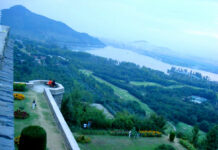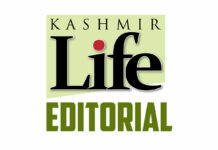Fo r a water abundant, energy deficit state like J&K, electricity has been more a crisis than a facility. In summers when discharge improves in rivers, the summer capital requires a lot of energy to cool its heels. In winters when the discharge is phenomenally low, entire Kashmir is dependent on the energy to manage sub Celsius temperatures. Neither in winter nor in summer has J&K enough of energy to manage its requirements, barring a few fortnights when Chenab flows ferociously.
r a water abundant, energy deficit state like J&K, electricity has been more a crisis than a facility. In summers when discharge improves in rivers, the summer capital requires a lot of energy to cool its heels. In winters when the discharge is phenomenally low, entire Kashmir is dependent on the energy to manage sub Celsius temperatures. Neither in winter nor in summer has J&K enough of energy to manage its requirements, barring a few fortnights when Chenab flows ferociously.
Over the years, it has had its own impact. While it belittles the idea of life in trying circumstances, it has been impeding growth. As soaring demand forces authorities to drive imports from Northern Grid, it drains a lot of revenue on the purchases. Given the dilapidated distribution network and partly due to a lackadaisical management system, the government is unable to raise the same amount that it invests in purchases. This has led to a massive mismatch between investment and the income that is a huge deficit statement. The losses increase with every passing year.
This was main reason why, at one point of time, the last government would offer a separate budget statement on the energy sector. It was abandoned by the incumbent coalition without any valid reason. The crisis remains. This is despite the fact that major investments are taking place in the energy sector and state’s fully owned Power Development Corporation would be showing a huge profit for the first time in its history.
But that does not end the crisis. It only begins. While various centrally sponsored schemes aimed at improving the transmission and distribution set up and are at different stages of implementation, the systems are yet to evolve properly. It is only a section of the consumers who pay and it is this section that is witnessing hike in tariffs. They can’t evade it because they are metered and registered. This leaves a much larger population of consumers outside the purview of the systems who do what they want; they are either population apparently unmanageable for the system because of their influence or their muscle power.
Last week led to a series of shocking revelations about who pays and who does not. There are end number of politicians and bureaucrats who have skipped paying the power tariff. And more recently, it was revealed that the ruling party is not paying the tariff of its post-militancy headquarters – the Nawa-ie-Subh complex. Though unreported, there are instances in which the influential cops and civil administration officers have used their security to chase away the electric department officials so that their load stays unchecked. All these revelations are condemnation of a system that is working on cross purposes with multiple standards.
Within next one decade, when the requirement of the state on energy front would have nearly doubled, the state is expected to be in a better position as far as generation goes. But if the transmission and distribution systems are not helped evolve professionally and fast, better availability will add to more losses and end up making crisis the only constant. State government has already decided to have a set of different distribution agencies which will function as commercial entities. Let all those ideas be put to test. It is better to start today than tomorrow. And let there be no politics on energy front.









